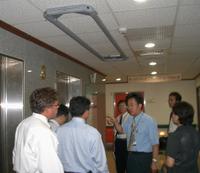August 1, 2003 – Can RFID help save a country from a massive outbreak of a deadly disease? Taiwan may be the first to find out. Authorities there have tested a system from Savi Technology
and are prepared to deploy it in all hospitals island-wide if there’s another outbreak of severe acute respiratory syndrome (SARS).
Taiwan is not the first country to realize that RFID can be used to track people who come in contact with a potential SARS patient. Two hospitals in Singapore have deployed an RFID system to track doctors and anyone else who visits a suspected SARS patient (see Singapore Fights SARS with RFID).
The systems are fairly similar. In Taiwan, the Industrial Technology Research Institute (ITRI), a research group funded by Taiwan’s Ministry of Economic Affairs, had tested Savi’s battery-powered EchoPoint tags and long- and short-range readers. When the government came to ITRI looking for help in tracking the spread of SARS, the research group recommended Savi’s RFID system.
“They looked at the technologies at their disposal and believed that RFID would be appropriate for a hospital environment,” says Bruce Jacquemard, executive VP and GM for global field operations at Savi, which is based in Sunnyvale, Calif. “They knew it would work correctly, and that was important because they needed to get something up and running quickly.”
It took just four weeks to deploy the technology, which includes the amount of time it took Savi to ship readers to Taiwan. Right now, the system is being used in only one hospital. But Taiwanese officials believe that there could be another SARS outbreak when the weather gets cooler, and if that happens, they are prepared to deploy RFID in all hospitals.
Unlike the system used in Singapore, which tracks visitors as well as hospital personnel, the Taiwanese system tracks only the medical staff. The belief is that known SARS patients won’t be allowed to have visitors, so the staff is more likely to spread the disease.
Each employee is given an EchoPoint 602 RFID tag, which is a little smaller and thicker than a credit card. The tag is put into a plastic pocket protector and carried by hospital personnel or worn with a chord round the neck. The system administrator records the name associated with the ID stored on each tag. The tag operates at 433 MHz and uses a battery for extra read range.
Savi 600 Series EchoPoint Signposts have been placed at key points throughout the hospital, including above hospital entries and exits, in doctor’s and nurses lounges, and the intensive care unit. Signposts are short-range readers that wake up the tags, so that the tags begin broadcasting their location and identification to Savi EchoPoint Readers, which can pick up the information from more than 300 feet away.
Readers on each floor pick up the tag ID and the ID of the Signpost that woke it up. That data is then transmitted to a Savi Site Manager, transforms it into location information that is communicated to the hospital’s local-area network, along with a time stamp. Because the system knows the name of the person connected to the tag ID and which Signpost was installed in which area, the system can effectively record who was in a certain area and when.
That information is stored in a database. Monitoring software developed by ITRI specifically for this project records enables hospital administrators to mine the data to find out who was in a particular area, how long he or she was there and who else was in the vicinity. This could control the spread of the disease in the advent of another outbreak.
“They are not tracking patients, because the patient can be isolated,” says Jacquemard. “Their objective really is to track the doctors and nurses who are moving through the hospital to see who they came in contact with.”
ITRI certified the Savi equipment to ensure that it could be used safely in a hospital under Taiwanese regulations and didn’t interfere with other RF devices in the hospital. Jacquemard says Taiwanese officials will take what they learned from this deployment and apply it to any broader rollout of the technology.


